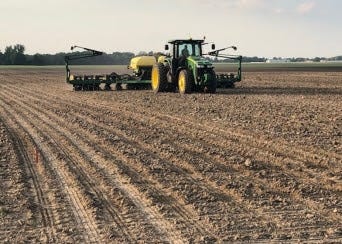March 22, 2024

Source: LG Seeds
“We don’t know what weather is coming our way this growing season,” says Greg Peters, an Iowa-based agronomist with LG Seeds. Technically, that’s true for any growing season. But given mild winter weather conditions and lingering drought in his area, he says it’s especially important for farmers to keep these things in mind heading into the 2024 crop season.
1. Mitigate risk with genetic diversity
“There’s no doubt in my mind, we’re going to be rain-dependent again this year, which is why it’s important farmers incorporate genetic diversity,” Peters says. A diversified hybrid lineup helps spread that risk and minimize losses.
For most farms, he recommends planting three or four hybrids, but of course that varies by individual and operation size. If you’re uncertain if you’re incorporating “enough” genetic diversity, just ask, he says.
2. Spread planting dates to limit threats
“Resist the temptation to plant too early,” Peters cautions, noting many will be tempted to plant in March after the mild winter. “The past three years, cool weather has come in March, April and May,” he reminds.
“Monitor the extended forecast and know there’s a lot of variation with it this year more than ever,” Peters advises. “Make sure you’re in a strong warming trend before planting.”
When heading to the field, Peters recommends farmers take their time and spread their planting dates. “That’s another way farmers can mitigate risk,” he says.

(Photo courtesy of LG Seeds) Farmers are encouraged to spread out their planting dates (when possible) and plant diverse genetics to limit risk.
3. Make sure seed is planted deep enough
“Anytime we’re dry, we field questions about planting depth,” Peters says. “For corn, I generally recommend a planting depth of 2.5 inches,” he says, noting there have been extreme cases when dryness necessitated going a bit deeper.
“Avoid planting shallower than 2 inches, because high variance in the soil moisture can create issues,” he says. “Two inches is the deepest we ever recommend on beans.”
Spotty rains during the 2023 season means farmers will likely encounter variances in soil moisture, Peters says. Therefore, it’s more important than ever to check planter results in every field.
Another common question Peters receives is about planter speed. More and more farmers are using high-speed planters, and his recommendations on planting speeds depend on what sort of tubes the planter has. “If you have a high-speed planter without high-speed tubes, our studies show 6.5 miles an hour is about the fastest you should go. If you’re planting faster than that, you need high-speed tubes.”
4. Be proactive with pest, disease and weed pressure
After the mild winter, the threat of insect pressure is elevated. “Make sure you’re using seed treatments,” Peters says, detailing farmers need to “look at insecticide on corn and possibly soybeans.” He continues, “Fungicide is also a good idea in case temperatures cool.”
Farmers also need to make sure they’re scouting for weeds regularly, especially those with no-till acres, to ensure weed pressure remains controlled. “Our earliest annuals have already started to emerge with the recent warmth,” Peters says. “I recommend an early burndown if weeds show quite a bit of height. You may even need to burn it down twice.”
What Mother Nature delivers is anyone’s guess. But steps like planting genetically diverse hybrids, spreading planting dates and using a high-quality seed treatment can help limit the risks and increase farmers’ odds of achieving their goals.
Source: LG Seeds
You May Also Like




